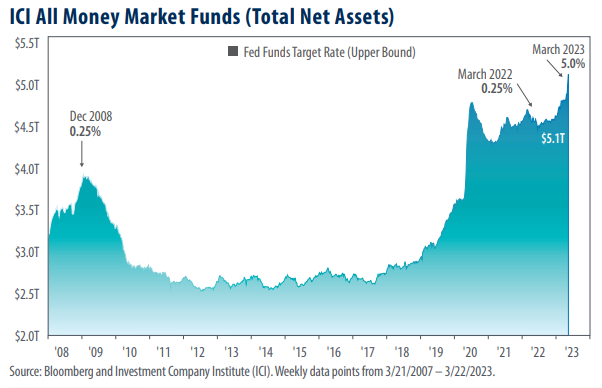
View from the Observation Deck
Today’s blog post offers a visual representation of trends in money market fund assets over time. As the chart reveals, it appears that investors tend to increasingly utilize money market funds during times of turmoil such as the financial crisis in 2008 – 2009 and the COVID-19 pandemic of 2020. Interestingly, a similar trend appears to have begun unfolding over the past several weeks (discussed in detail below). A note about the chart: we use the federal funds target rate (upper bound) as a proxy for short-term interest rates, such as those offered by taxable money market funds and other savings vehicles. In our opinion, this proxy may offer insights into the potential effect of short-term rates on investor behavior.
• U.S. money market fund assets stood at a record $5.1 trillion as of 3/22/23 (most recent data).
As of 3/22/23, total money market fund assets were approximately $1.21 trillion and $340 billion higher than where they stood on 1/14/09 (peak during financial crisis) and 5/20/20 (peak during COVID-19 pandemic), respectively. Recent developments involving the global banking system likely contributed to the record high, in our opinion, sending total net assets invested in money market funds surging by 4.87% between 3/1/23 and 3/22/23. Tellingly, total assets invested in money market government funds (not broken out in the chart), which restrict their holdings to U.S. Treasuries and agency debt, increased by 6.57% over the same period. For comparison, total assets invested in so-called “prime” money market funds (not broken out in the chart), which expand their holdings to short-term corporate debt among other non-governmental debt instruments, decreased by 2.07% over the period.
• From March 2020 to March 2022, the Federal Reserve (“Fed”) kept the federal funds target rate (upper bound) at 0.25%, according to data from the Fed. Since then, the Fed has initiated nine increases to the federal funds target rate (upper bound), raising it from 0.25% to 5.0% as of 3/23/23.
• The Fed’s balance sheet of assets stood at $8.73 trillion on 3/22/23, up significantly from the $2.24 trillion level at the close of December 2008, according to data from Bloomberg.
Even though the Fed has stated it will continue shrinking its balance sheet by $95 billion per month, the total assets on the Fed’s balance sheet have risen by nearly $394 billion since the beginning of March. In our view, a portion of the Fed’s balance sheet growth may be related to banks taking advantage of its primary lending window as well as the newly established Bank Term Funding Program.
Takeaway
Total net U.S. money market fund assets stood at a record $5.1 trillion as of 3/22/23. In our view, recent developments in the banking system, including the second-largest bank failure since the 2008 financial crisis, may be driving investors to take positions in less-risky assets. Since 3/1/23, total assets invested in government money market funds, which restrict their holdings to U.S. Treasuries and agency debt increased by 6.57%. For comparison, prime money market funds, which can invest in short-term corporate debt such as corporate paper and bank-issued certificates of deposit, saw total assets decrease by 2.07% over the same period. Total assets on the Fed’s balance sheet stood at $8.73 trillion on 3/22/23, representing a month-to-date increase $394 billion. We will continue to monitor cash flows to see how investors respond to the Fed’s actions and market events moving forward.



